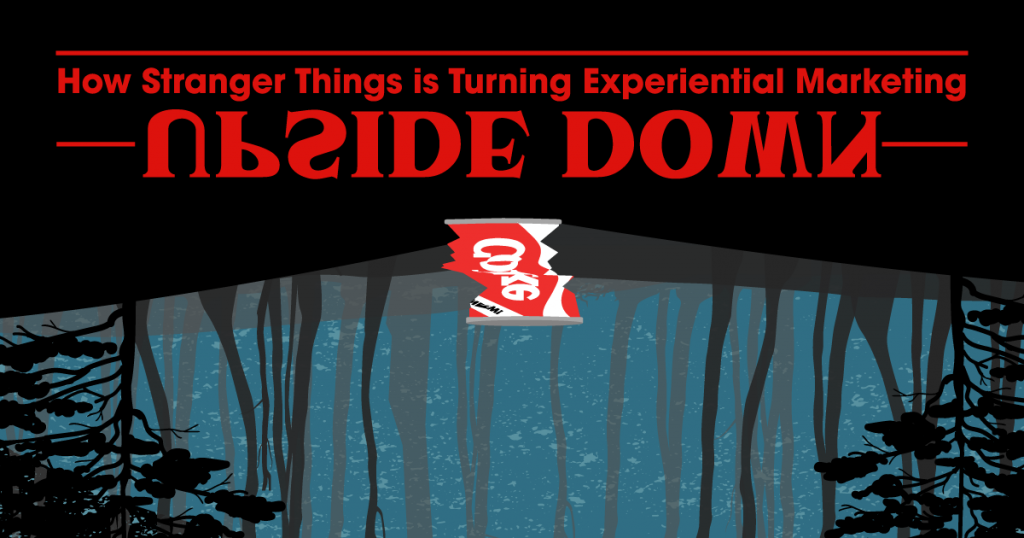How Stranger Things is Turning Experiential Marketing Upside Down
August 16, 2019 In Uncategorized Leave a comment
August 16, 2019 In Uncategorized Leave a comment

If you’ve been wondering how the third season of Netflix’s Stranger Things has managed to generate so much hype over the past month, the answer is clear: genius marketing.
Netflix recently announced that the latest season of their hit show, Stranger Things, was watched more times in its first four days of release than any other movie or show on their platform. Naturally, this type of success doesn’t happen overnight.
Aside from Winona’s triumphant return to acting, there are plenty of reasons for the collective obsession with Stranger Things. From the ultra-likable kid actors to ample doses of 80s nostalgia, Stranger Things, as a brand, has gotten so many things right. And from a marketing standpoint, there are few shows in recent memory that have garnered as much fanfare.
So, how did they do it?
There’s no denying Stranger Things is good TV (Demogorgons! Waffles! Give us more). This sci-fi tale has long had all the makings for a tried and true classic. Part action, part mystery, and part extraordinary tale of friendship, Stranger Things has blown the competition away in terms of originality.
But how does an ordinary Netflix show go from one-season wonder to pop culture obsession?
How did a sci-fi show like Stranger Things thrust itself into the throes of super-fandom?
Good Ol’ 80s Nostalgia
Stranger Things, in a bid to connect with their audience on a deeper level, utilized immersive doses of nostalgia to tug at our heartstrings. From protagonists seemingly pulled straight out of The Goonies to 80s references to everything from music to big brands like Burger King, the appeal of nostalgia in today’s hyper-futuristic world is indisputable, and it’s making big bucks for the brands that use it to sell.
Takeaway: In a world inundated with endless products to choose from, you’ve got to make yours stand out. Capturing your audience’s attention through the power of nostalgia is just one of the brilliant marketing tactics Stranger Things has perfected.
Product Placements
The common consensus is that product placements, in a nutshell, suck. They are rooted in capitalism, and they are often thought to take away from a film or show’s heart and soul.
Or do they?
Stranger Things is the king of product placements, but somehow, it just works. And it doesn’t feel phony, either. Coca-Cola, Cadillac, Chevrolet, Casio, 7-Eleven, Sharp, Adidas, Pentax, Reebok, and Burger King, and the list just goes on and on. This kind of cross-promotion is often overlooked for businesses in the real world, but all it may take is a little creativity to come up with your next big campaign.
Interactive Ads
Connecting with your audience on an emotional level is important, but so is engagement. It’s not enough to just capture your audience’s attention. You’ve got to make them want to interact with your brand. This can be done in myriad ways, but the weapon of choice for today’s companies is the use of interactive ads that dazzle the senses. And while Stranger Things is a show that capitalizes on pop culture icons of the past, it certainly knows how to incorporate the future of marketing tactics into its campaigns. Case in point: AR.
Augmented reality isn’t exactly a new marketing method, but one slowly beginning to gain traction as the technology behind it becomes more widespread. For a show as immersive as Stranger Things, AR is bound to make an impact.
In 2017, the show partnered with Snapchat to launch a 3D lens that led to the Upside Down. Another allowed users to overlay their selfies with Eleven’s oh-so-adorable nosebleed. If you’re not utilizing social media for this kind of thing, you may be missing out on a great way to connect with your audience.
Strategic Partnerships
Collaborations may very well be a wise move if your budget allows it and it makes sense for your business. For Stranger Things, it did.
In October 2017, just ahead of the premiere of the second season of Stranger Things, the show partnered with Spotify to create a fun fan experience. The black and green media player was transformed into The Upside Down, complete with floating spores and a creepy flashlight beam. That same month came a strategic partnership with Lyft, which celebrated the show’s premiere by adding a “Strange Mode” for rides across certain major U.S. cities. Touted as a “free ride to the Upside Down” this fan experience was just enough to cause a stir, putting Stranger Things forefront in the minds of select Lyft riders across Los Angeles and Philadelphia.
And in a more recent development, Netflix announced a partnership with Microsoft to revive Windows 1, the operating system that became popular in 1985, the same year Stranger Things was set. By all accounts, everyone’s favorite sci-fi show has big plans brewing for seasons to come, and we can’t wait to see it all unfold.
In a digital world filled with an infinite string of shows to binge, competition is sky-high. If you’re hoping to make a Stranger Things-like splash in your industry, the time to start is now. Don’t let your competitors turn your business upside down. Call Triggers to learn more about how our digital marketing experiences can help you get noticed.